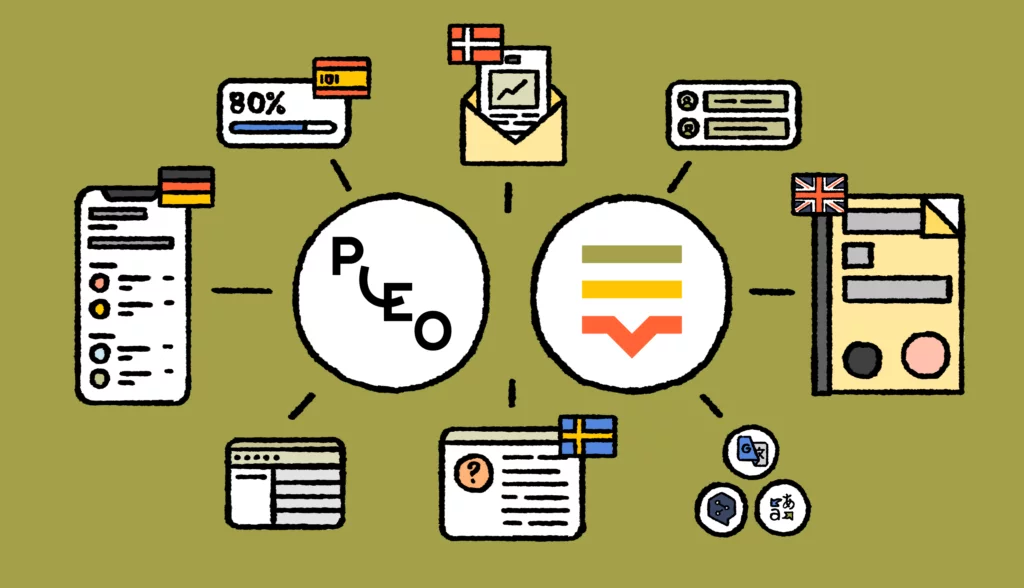Revolut now supports 20+ languages in over 30 countries. Performing localization at this scale is a significant undertaking. In order to maintain the current languages and launch new languages smoothly, it involves:
- Input and coordination from multiple stakeholders across the company and external partners
- Keeping track of end-to-end timelines to ensure fast turnarounds
- Using and building the right tools and automations
- Maintaining quality standards at scale
Working with in-house resources and external partners
When we researched in-house versus outsourced localization, we concluded that the future of localization is hybrid. This is true for Revolut. They work with two translation partners as well as a team of in-house linguists.
At Revolut, ownership of localization remains in-house. They are committed to controlling the localization process to ensure quality standards at scale. Here’s what that looks like in terms of team structure according to Jorell Langmar, Head of Content Localization at Revolut:
“Ideally, we would have a two-person team for each of the languages (a copywriter and language owner) and, on top of that, two production managers helping to run the daily operations of these duos. We’re not there yet (not every language has two people for review), but we’re a fairly big team and keep growing.”
Custom integrations with language partners
We’ve written extensively about working with language vendors: choosing the right translation company, collaborating effectively, and controlling costs. Successful localization depends on collaborating with your language partner to deliver the best results for you and your customers, which means considering vendors to be an extension of your team.
The best way to do that? Adopting TMS technology that centralizes collaboration between your in-house stakeholders and an outsourced linguistic team. The Lokalise-Revolut-LSP integration is how Revolut builds automation processes with their partners to cover:
- Daily checks on jobs being assigned
- Pre-processing and importing content to their preferred CAT tools
- Performing translations
- Delivering back to Lokalise (with post-processing steps)
This automated workflow also includes careful checks to ensure partners don’t return redundant translations. Lokalise acts as a single source of truth for the latest copy and translation versions.
With so many moving parts, internal stakeholders, and external partners, how does it all happen in practice?
Revolut’s localization automation – a finely tuned process that runs like clockwork
Think of all the contributors Revolut has working on localization. As the number of languages and contributors increases, so does the risk of potential challenges.
Note: this tends to be true regardless of whether you’re working with freelance translators, vendors, or in-house translators.
The key to managing a scaling operation is centralization. Adopting a centralized, collaborative platform that serves as a single source of truth for everyone participating in the localization process ensures everyone is working from the same set of information and keeps them focused on the same priorities.
Language process project management
Every day, newly added or updated translatable content gets split between an in-house team of linguists (language owners and copywriters) and external language partners. This process is largely automated, allowing Revolut to repeatedly launch new content in 1 to 3 business days, cover spikes in translation volume, and balances the load when team members are absent.
Here’s how they do it:
Revolut’s content lives in the Lokalise TMS. It’s structured in projects and assigned a priority level based on importance and expected turnaround time. Note: a project is a folder with different files associated with the same product/team (e.g., mobile apps, emails, website, etc.).
High-priority projects get assigned to Revolut’s in-house team up to their maximum capacity. For this, Revolut has built daily automation with Lokalise and their internal product, which:
- Scopes all translatable content across all projects in the form of “effective words” to be translated* (volumes of translatable content). Note: “Effective words” refers to the number of source words to be translated, adjusted for translation memory leverage and linguist productivity.
- Checks linguist availability internally (to cover absence).
- Checks linguist backlogs from the previous day (additional translation volumes to be covered today).
- Checks linguists’ maximum capacity per day (linguists have their thresholds adjusted for productivity).
- Creates translation tasks, assigning copywriters (as the 1st priority) to work on translation tasks up to their maximum effective word capacity thresholds.
- For translatable content above the threshold, it creates translation tasks, assigning language owners (as the 2nd priority) to work on translation tasks up to their maximum effective word capacity.
The same automation, depending on the project and priority, creates translation tasks for their language partners. Up to this point, the task creation and distribution process is fully automated. The Revolut team doesn’t need to lift a finger to make this happen on a daily basis; this includes tracking progress with dashboards that retrieve data from Lokalise’s API.
We asked Jorell what it would take to run the processes manually. He says “It’s not comparable; some steps within the same flow would be nearly impossible without automation.” (i.e., calculating effective word counts and creating suitably sized tasks for linguists).
“Without automated task creation and assignment, we would need a bigger team to deal with this part alone. Plus, the way assigning is done now probably wouldn’t even be possible manually,” explains Jorell.
Automation provides many benefits, including scalability and better content distribution. And thanks to Lokalise webhooks, we’re able to create our changelogs, allowing us to deal with issues more quickly and efficiently. This all allows us to scale.
Covering spikes in translation volumes and ad hoc requests
At Lokalise, we sometimes hear from partners that the task creation cycle cannot be fully automated. They need a human touch to address changing priorities, and edge cases for content. While this is true for Revolut, they have a solution:
When translation volume spikes, non-distributed translatable content gets automatically assigned to Revolut’s backlog for the next day.
“We place some tasks and projects in our backlog, and then our production manager assesses the benefits of sending a task to our partners vs. waiting a day to assign it to our in-house team. We’ve built our UI for bulk reassignment of tasks from our backlog to various counterparties to speed up the process of task reassignment,” says Jorell.
Jorell shares that they also have a way to trigger task creation on an ad hoc basis when something needs to be translated urgently. That said, the existing automation is invaluable in terms of being able to ship more content.
Performing linguistic quality assurance (LQA) to ensure quality standards at scale
“Our goal is to have perfectly localized content. It’s extremely important to have high-quality content that sounds fluent and native, as this is the first step to gaining clients’ trust in local markets.”
In our case study, we covered why quality is so important in Revolut’s localization. Here, we dive deeper into the revision and LQA program that enforces it.
Revolut’s automated review process
Revolut handles all review steps internally and uses automation to allocate tasks to team members. Copywriters and language owners are automatically assigned review tasks based on their bandwidth:
- Language owners and copywriters review translations after one another (translations done in-house)
- Language owners review translations performed by external partners
This ensures consistency of translations, messages, and brand voice since content is reviewed internally at Revolut. To make the process more efficient, during the revision process, translation issues are fixed, logged, ranked, and categorized based on the in-house linguistic quality assurance framework (LQA program).
Iterative feedback loops that highlight improvement opportunities
Data on translation quality (and changes made) gets retrieved from Lokalise and analyzed in the form of quality dashboards and reports built by Revolut. It is used for alignment calls with vendors and in-house linguists, as well as for identifying the root cause of translation errors to ensure mitigation strategies are implemented.
Currently, reports are processed semi-manually, but the team is building another automation for translation quality report generation that is estimated to save ~400 hours/month for language owners participating in alignment calls.
The end state Revolut seeks is: translation errors get fixed and categorized simultaneously, while revision is done in Lokalise, resulting in automatic API-generated reports (changelogs with translation errors) sent directly to partners.
Lokalise is the single source of truth
Lokalise helps Revolut ensure a single source of changes with all the latest translations, and most recent translation memory updates. The team (developers, product people, localization managers, language owners, copywriters) know where to add/update the content to make sure changes are consistently reflected in internal and external tools.
As the content is revised in Lokalise, changes and feedback need to be shared with the parties, who translate pieces of content in their own CAT tools. The most dynamic localization asset is the translation memory (TM), which needs to be up to date, as it records all translations entered and provides suggestions for future translations for consistency and efficiency.
The translation partners have built their automation to ensure that all updated content within Lokalise makes it back to their TMS at least daily.
So, what’s next for Revolut?
In our session on the Localization Maturity Model, our Lead Sales Solutions Architect, Tom Franc, discussed what companies need to focus on at each of the 5 stages (5 being a “state-of-the-art”/ideal state). Here’s how Jorell envisions the dream state for his localization team:
“The ideal state for us is where I, as a localization manager, am not needed. Meaning that we’ve reached the maximum efficiency of processes and the desired quality of translations. We are not there yet. Being good is not enough – we strive for perfection.”
As they say at Revolut, never settle. Their localization team has quite the packed roadmap for new automation and process improvements already; a plan that would allow them to make the most of their investment.




